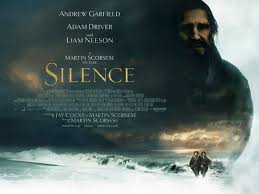The latest film from auteur, Martin Scorsese, continues his fascination with Christian themes, evident from his very first movies and climaxing in 1988 with The Last Temptation of Christ. But this 2016 offering delves more deeply than his earlier preoccupations and easy box-office draws of guilt, sex and death. Centered on the empty space where faith lives, the whole movie shudders with the terror and joy of living in that space. As such it is by far Scorsese’s most religious movie, one which turns in near orbit to the heart of Christian meaning. In the words of the Newsweek review it “feels close to a state of grace.” 
Silence tells the story of Jesuit priests fallen foul of 17th century Japanese state policy to root out Christianity from the nation, concentrating particularly on the coastal areas of Nagasaki where the faith of Jesus has gained a foothold. The film is based on the 1966 novel of the same name by Shusaku Endo. The movie narrative remains faithful to the cruel dilemma presented in the book and, on one level, to its title theme, communicated with echoing intensity in the written story, that of God’s apparent silence in the face of appalling suffering.
But Scorsese as director does not just tell a story, he presents us with a sumptuous gallery of scenes and images. The sea and its beating waves are a constant motif, signaling the unbridgeable isolation of the Jesuit missionaries, way beyond return to their native Portugal. The implacable sea is also an instrument of torture for the island Christians, hung on crosses before the incoming tide, battered and swamped until their spirits give out. But then there is this. 
The image of Christ is also continuously represented– hung on the cross, the Lamb of God standing defenceless, or a face gazing serene and unflinching out into the world. It is this portraiture–always itself a figure of torture–which acts as an unyielding counterpoint to the brutal campaign of violence carried out by the authorities.
The dilemma standing before the priests is, first, whether or not to advocate apostasy among the Japanese Christians rather than see them continue to suffer this campaign, and then, ultimately, whether or not to apostatize themselves–the last condition for its cessation. Our attention is riveted by this enforced decision, but underlying it and informing it all the way through is a profound, often mind-bending discussion on what is actually at stake.
Toward the end of the movie the central Jesuit character, Rodrigues (Andrew Garfield), has a conversation with his former teacher and mentor, a Jesuit who has already apostatized, Ferreira (Liam Neeson). Ferreira tells him that the Japanese Christians are not real Christians, because the word used for “the Son of God” is the same Japanese expression as for the midday sun! They do not believe in “Deus” (scholastic Latin for “God”), so why put them through torture for the sake of a phony belief!
This is an argument by one priest to another. Meanwhile the Japanese authorities have something quite different bothering them. They are concerned to keep encroaching Western nations out of Japan–Spain, Portugal, the Netherlands. And they see Christianity as a bridgehead for this encroachment. Their concern was doubtless valid, but as they argue with Rodrigues they claim that Christianity cannot possibly take root in Japan because it was alien to its soil. Saying so they somehow manage to ignore the multiple thousands of existing Christian converts, plus their own ferocious effort to eradicate what is apparently unable to put down roots. Essentially, however, their argument is not empirical. They are claiming on authority to decide what takes root and what cannot. They are the shogunate officer and warrior class, the appointed curators of what is Japanese.
In the course of this authoritative argument, however, they quote a Japanese saying and suddenly we are at another level altogether. “Mountains and rivers can be moved. But man’s nature cannot be moved.” I do not think this line is in Endo’s book, in which case the screenwriting of Silence adds a crucial twist, suggesting that the thing at stake is not who is in charge, but what, in the end, it means to be human.
 This is a hugely different question and it is at this level that the repeated images of Christ–unfailingly nonretaliatory and nonviolent–transcend the eponymous silence of God. Indeed, the test of apostasy is to trample on an image of Christ and this gives Scorsese endless occasions throughout the movie to render a powerful semiotics of the nonretaliation of the Christ. Jesus again and again has a foot planted on his face and not once is there a glimmer of revenge.
This is a hugely different question and it is at this level that the repeated images of Christ–unfailingly nonretaliatory and nonviolent–transcend the eponymous silence of God. Indeed, the test of apostasy is to trample on an image of Christ and this gives Scorsese endless occasions throughout the movie to render a powerful semiotics of the nonretaliation of the Christ. Jesus again and again has a foot planted on his face and not once is there a glimmer of revenge.
Is not this perhaps the deafening “silence” that is complained about? The fact that the God of Jesus cannot and will not intervene violently, even to end abusive violation of his own revealed image? In any case, the authorities are obsessively concerned to eliminate these symbols of Jesus when kept by Christians, sensing that somehow they are key to the meaning and communication of the faith. I do not know what the actual attitude of the Nagasaki Christians or the authorities was toward the images–whether or not they regarded them superstitiously as some kind of object-with-power. But there can be no doubt that Scorsese choreographs the figures and faces for their iconic value, representing exactly the other nature which the saying about mountains and rivers deemed impossible.
In which case Ferreira–at least in the world of the movie–was entirely wrong. The Japanese Christians were real Christians, because they treasured the nonviolent semiotics of the cross. In Silence Scorsese has articulated, as artist and director, a clamant cinema of Jesus’ nonretaliation and its ultimate victory. The final frame of the movie and its sudden close-up makes this unquestionable. If you have not seen the movie treat yourself for the sake of all the wonderful screenplay, but above all the “apocalyptic” (revelatory) finale.
Silence speaks louder than words, louder than apostasy itself.
Deeply moving especially in the light of the work of Takashi Nagai for whom the thriving of Christian faith in Nagasaki became a beacon for his life, which eventually nourished the faded hopes and withered lives of many victims of the Nagasaki bombs.
I felt when I watched ‘Silence’ that the world could easily believe that this story was about the end of Christian faith in Japan. Far from it!
Thank you for your valuable comment, John. Sorry it took me so long to see it! Yes, “far from it” indeed.